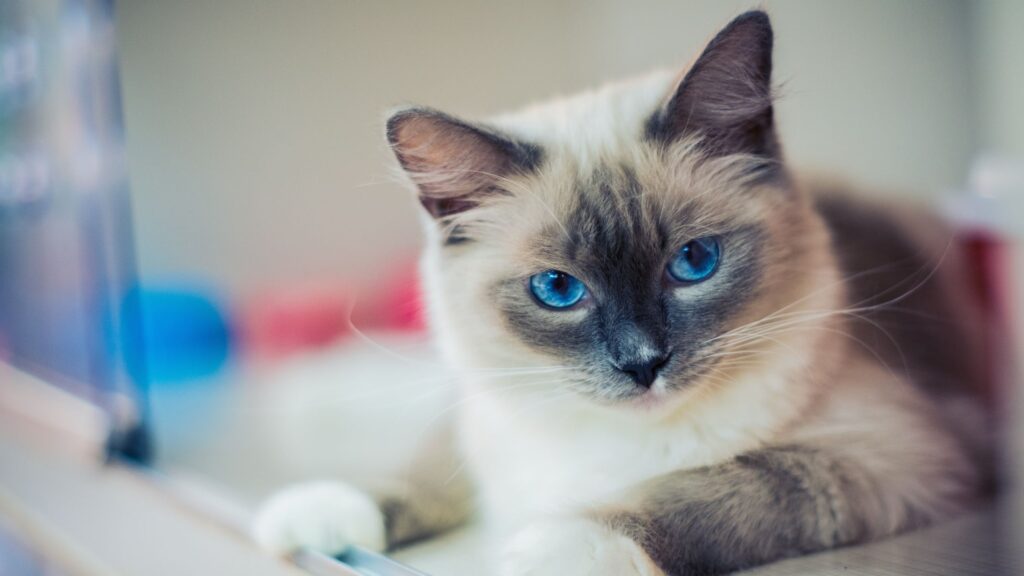
The Ragdoll cat is one of the most beloved and distinct breeds in the feline world, known for its striking appearance, gentle nature, and affectionate demeanor. With their bright blue eyes, plush coat, and endearing habit of going limp when picked up (hence the name “Ragdoll”), these cats have captured the hearts of cat lovers everywhere.
History of the Ragdoll Cat
Ann Baker, a breeder from California, is credited with developing the Ragdoll breed in the 1960s. The original breeding stock came from a white Persian/Angora mix, and over time, through selective breeding, the Ragdoll’s signature traits of calmness and affection were enhanced. Today, Ragdolls are one of the most popular breeds in the United States and beyond.
Characteristics of the Ragdoll Cat
Ragdoll cats are often described as the “puppy-like” cats of the feline world. Here are some of their key characteristics:
- Size and Build: Ragdolls are one of the largest domestic cat breeds, with males typically weighing between 15 to 20 pounds and females between 10 to 15 pounds. They have a sturdy, muscular build with a long, plush coat that adds to their size.
- Eye Color: One of the most recognizable features of the Ragdoll cat is its deep blue eyes, which can range from a light to a deep, almost sapphire color.
- Coat: Ragdolls have a semi long-haired coat that is soft and silky to the touch. Despite their fluffy appearance, their coat does not mat as easily as some other longhaired breeds, making grooming relatively easy.
- Color Patterns: Ragdolls come in a variety of color patterns, including colorpoint, mitted, and bicolor. The typical colors are seal, blue, chocolate, and lilac
Temperament and Personality
Ragdolls are known for their incredibly sweet and easygoing nature. Often referred to as “gentle giants,” they thrive on human companionship and enjoy being around people. They are typically friendly, affectionate, and tolerant, making them excellent family pets. Ragdolls are not as independent as some other cats and prefer to be near their owners, often following them around the house like a dog.
Their name, Ragdoll, comes from their tendency to go limp and relaxed when held. They love being cradled, and their docile nature makes them great companions for children and other pets. Although these cats appear relaxed, they are also fond of playing and engaging with interactive toys and games.
Grooming and Care
Although this breed have long, silky fur, they are considered to be relatively low-maintenance when it comes to grooming. Brushing them once or twice a week is usually enough to keep their coat in good condition and prevent tangles or mats. During shedding season, more frequent brushing may be needed to manage loose hair.
They also require regular care, such as trimming their nails, cleaning their ears, and ensuring good dental hygiene. They are generally healthy cats, but regular vet checkups are essential to maintain their health.
Diet and Health Considerations
Ragdolls are large cats, so it’s important to provide them with a balanced diet that meets their nutritional needs. A high-quality cat food that is rich in protein is ideal for maintaining their muscular build and shiny coat. Portion control is important, as they are prone to obesity due to their relaxed nature and lack of exercise.
Though generally healthy, this cat breeds are predisposed to a few genetic health issues, such as hypertrophic cardiomyopathy (a form of heart disease). Regular veterinary checkups and early screenings can help manage or prevent these health concerns.
Common Health Issues
- Hypertrophic Cardiomyopathy (HCM): This is a common heart condition found in many cat breeds, including Ragdolls. It’s important to have your Ragdoll screened for HCM by your vet, especially if there’s a history of it in their breeding line.
- Obesity: Due to their large size and laid-back nature, they can easily become overweight. Regular exercise through play and a controlled diet are key to keeping them healthy.
- Urinary Tract Issues: Some may experience urinary tract problems, so providing them with plenty of fresh water and a high-quality diet is essential.
Is the Ragdoll Cat Right for You?
If you’re looking for a cat that is affectionate, laid-back, and great with families, the Ragdoll cat is an excellent choice. Their friendly, docile personality makes them ideal for households with children or other pets. They love attention but are not overly demanding, and their relatively low grooming needs make them a manageable longhaired breed. However, it’s important to note that they thrive on companionship and may not do well in homes where they are left alone for long periods.
The Ragdoll cat is a breed like no other, blending beauty, size, and a unique temperament that makes them a joy to have as a companion. With their striking looks, calm personality, and endearing affection for their humans, they easily become cherished members of any household. Whether you’re a long-time cat owner or new to feline companionship, this breed is sure to win your heart.
Frequently Asked Questions
1. What makes Ragdoll cats unique?
Ans: They are known for their large size, striking blue eyes, and plush coat. Their gentle, docile nature and tendency to go limp when picked up make them unique and beloved as companions.
2. Are Ragdoll cats good for families with children and other pets?
Ans: Yes, they are extremely friendly and tolerant, making them great for families with children or other pets. Their laid-back temperament ensures they interact well in most home environments.
3. How much grooming does they require?
Ans: Ragdolls have semi-longhaired coats that require weekly brushing to prevent tangles. Despite their fluffy appearance, their coats are relatively low-maintenance compared to other longhaired breeds.
4. Are Ragdolls indoor cats or can they go outside?
Ans: These cats are best kept as indoor cats due to their trusting and relaxed nature. They lack strong survival instincts and may not fare well outdoors without supervision.
